Development of a Probabilistic Seismic Performance Assessment Model of Slope Using Machine Learning Methods
Abstract
1. Introduction
2. Materials and Methods
2.1. Data Acquisition: Seismic Slope Fragility Assessment
2.2. Data Description
2.3. Machine Learning Methods
2.3.1. Artificial Neural Network
2.3.2. Support Vector Machine
2.3.3. Gaussian Process Regression
3. Results and Discussion
- The MLR-based model tends to predict the actual value of the input variables well on the output values between HCLPF 0–3 g, but the variance of the predictive values is large. Further, for HCLPF values 3 g or more, a value smaller than the actual value is predicted, and our results confirmed that the prediction ability was remarkably deteriorated.
- The MLR-based model considering the interaction among input variables simulates the actual values of input variables well on average regarding the output values between the HCLPF values of 0–6 g, but the variance of these results is still large. Additionally, we confirmed that the model yields a biased value that is less than the actual value for an HCLPF value of 6 g or more.
- The MPR model predicts the actual values for the input variables well for output values of HCLPF between 0–6 g, and the variance of the predicted values is relatively small compared with the existing MLR model. However, in the value range of more than HCLPF 6 g, a biased value smaller than the actual value is still predicted.
- The SVM model predicts the actual values of the input variables well for the output values between the HCLPF values of 0–6 g compared with the MPR model, and the variance of these predicted values is also relatively small. However, it still does not show a satisfactory accuracy in the range of more than an HCLPF of 6 g.
- The ANN and GPR models predict the actual value of the input variables almost exactly in the range of all the HCLPF values compared with the previously mentioned models, and the variance of such predicted values is also quite small. The ANN and GPR models show similar predictive performances, but the GPR model predicts more closely to the actual values than the ANN does. That result is quantitatively observed in Table 2 and Figure 8.
4. Conclusions
Author Contributions
Funding
Acknowledgments
Conflicts of Interest
Abbreviations
| Acronyms | Description |
| SVM | Support vector machine |
| ANN | Artificial neural network |
| GPR | Gaussian process regression |
| HCLPF | The high-confidence-low-probability-of-failure |
| MLP | Multi-layer perceptron |
| SMO | Sequential minimal optimization |
| CL | Confidence Level |
| R | The linear correlation coefficient |
| R2 | The coefficient of determination |
| MAE | Mean absolute error |
| RMSE | Root mean squared error |
| MLR | Multiple linear regression |
| MPR | Multiple polynomial regression |
| MLR w/int. | Multiple linear regression with interaction |
References
- Park, S.; Kim, W.; Lee, J.; Baek, Y. Case study on slope stability changes caused by earthquakes—Focusing on Gyeongju 5.8 ML EQ. Sustainability 2018, 10, 3441. [Google Scholar] [CrossRef]
- Jessee, M.A.N.; Hamburger, M.W.; Ferrara, M.R.; McLean, A.; FitzGerald, C. A global dataset and model of earthquake-induced landslide fatalities. Landslides 2020, 1–14. [Google Scholar] [CrossRef]
- Statistical Research Institute. Korean Social Trends 2017; 11-1240245-000014-10; Statistics Korea: Daejeon, Korea, 2017.
- Naik, S.P.; Gwon, O.; Park, K.; Kim, Y.S. Land damage mapping and liquefaction potential analysis of soils from the epicentral region of 2017 Pohang Mw 5.4 earthquake, South Korea. Sustainability 2020, 12, 1234. [Google Scholar] [CrossRef]
- Park, H.J.; Ha, J.G.; Kim, S.H.; Jo, S.S. Seismic performance of ancient masonry structures in Korea rediscovered in 2016 M 5.8 Gyeongju earthquake. Sustainability 2019, 11, 1565. [Google Scholar] [CrossRef]
- Kwag, S.; Ryu, Y.; Ju, B.S. Efficient seismic fragility analysis for large-scale piping system utilizing Bayesian approach. Appl. Sci. 2020, 10, 1515. [Google Scholar] [CrossRef]
- Terzaghi, K. Mechanism of landslides. In Application of Engineering to Geology; Geological Society of America, Inc.: Boulder, CO, USA, 1950; pp. 83–123. [Google Scholar]
- Newmark, N.M. Effects of earthquakes on dams and embankments. Geotechnique 1965, 15, 139–159. [Google Scholar] [CrossRef]
- Jibson, R.W. Methods for assessing the stability of slopes during earthquakes—A retrospective. Eng. Geol. 2011, 122, 43–50. [Google Scholar] [CrossRef]
- Ambraseys, N.N.; Menu, J.M. Earthquak-induced ground displacements. Earthq. Eng. Struct. Dyn. 1988, 16, 985–1006. [Google Scholar] [CrossRef]
- Yegian, M.K.; Marciano, E.A.; Ghahraman, V.G. Earthquake-induced permanent deformations: Probabilistic approach. J. Geotech. Eng. 1991, 117, 35–50. [Google Scholar] [CrossRef]
- Jibson, R.W. Predicting earthquake-induced landslide displacements using Newmark’s sliding block analysis. Transp. Res. Rec. 1993, 1411, 9–17. [Google Scholar]
- Jibson, R.W.; Harp, E.L.; Michael, J.A. A Method for Producing Digital Probabilistic Seismic Landslide Hazard Maps: An Example from the Los Angeles, California, Area; U.S. Geological Survey Open-File Report 98–113; US Department of the Interior, US Geological Survey: Washington, DC, USA, 1998.
- Jibson, R.W.; Harp, E.L.; Michael, J.A. A method for producing digital probabilistic seismic landslide hazard maps. Eng. Geol. 2000, 58, 271–289. [Google Scholar] [CrossRef]
- Jibson, R.W. Regression models for estimating coseismic landslide displacement. Eng. Geol. 2007, 91, 209–218. [Google Scholar] [CrossRef]
- Rathje, E.M.; Antonakos, G. A unified model for predicting earthquake-induced sliding displacements of rigid and flexible slopes. Eng. Geol. 2011, 122, 51–60. [Google Scholar] [CrossRef]
- Schneier, H.R.; Schneider, M.A. Modern Geotechnical Design Codes of Practice; Arnold, P., Fenton, G.A., Hicks, M.A., Schweckendiek, T., Simpson, B., Eds.; IOS Press: Amsterdam, The Netherlands, 2013; pp. 87–101. [Google Scholar]
- Yiannis, T.; Nikos, D.L.; Prodromos, N.P.; Evaggelos, C.G. Probabilistic seismic slope stability assessment of geostructure. Struct. Infrastruct. Eng. 2008, 6, 179–191. [Google Scholar]
- Wu, X.Z. Development of fragility functions for slope instability analysis. Landslides 2015, 12, 165–175. [Google Scholar] [CrossRef]
- Xu, B.; Low, B.K. Probabilistic stability analyses of embankments based on finite-element method. J. Geotech. Geoenviron. Eng. 2006, 132, 1444–1454. [Google Scholar] [CrossRef]
- Huang, J.; Griffiths, D.V.; Fenton, G.A. System reliability of slopes by RFEM. Soils Found. 2010, 50, 343–353. [Google Scholar] [CrossRef]
- Kim, J.M.; Sitar, N. Probabilistic evaluation of seismically induced permanent deformation of slopes. Soil Dyn. Earthq. Eng. 2013, 44, 67–77. [Google Scholar] [CrossRef]
- Lagaros, N.D.; Tsompanakis, Y.; Psarropoulos, P.N.; Georgopoulos, E.C. Computationally efficient seismic fragility analysis of geostructures. Comput. Struct. 2009, 87, 1195–1203. [Google Scholar] [CrossRef]
- Park, N.-S.; Cho, S.-E. Development of seismic fragility curves for slopes using ANN-based response surface. J. Korean Geotech. Soc. 2016, 32, 31–42. [Google Scholar] [CrossRef][Green Version]
- Kwag, S.; Hahm, D. Development of an earthquake-induced landslide risk assessment approach for nuclear power plants. Nucl. Eng. Technol. 2018, 50, 1372–1386. [Google Scholar] [CrossRef]
- Kwag, S.; Hahm, D. A Study on PSA approach for Nuclear Power Plants Considering Earthquake-induced Slope Failure; KAERI/TR-0000/2020; Korea Atomic Energy Research Institute (KAERI): Daejeon, Korea, 2019. [Google Scholar]
- Samui, P. Slope stability analysis: A support vector machine approach. Environ. Geol. 2008, 56, 255. [Google Scholar] [CrossRef]
- Das, S.K.; Samui, P.; Sabat, A.K. Prediction of field hydraulic conductivity of clay liners using an artificial neural network and support vector machine. Int. J. Geomech. 2012, 12, 606–611. [Google Scholar] [CrossRef]
- Samui, P. Determination of friction capacity of driven pile in clay using Gaussian Process Regression (GPR), and Minimax Probability Machine Regression (MPMR). Geotech. Geol. Eng. 2019, 37, 4643–4647. [Google Scholar] [CrossRef]
- Yan, K.; Dai, Y.; Xu, M.; Mo, Y. Tunnel surface settlement forecasting with ensemble learning. Sustainability 2020, 12, 232. [Google Scholar] [CrossRef]
- Thai Pham, B.; Shirzadi, A.; Shahabi, H.; Omidvar, E.; Singh, S.K.; Sahana, M.; Talebpour Asl, D.; Bin Ahmad, B.; Kim Quoc, N.; Lee, S. Landslide susceptibility assessment by novel hybrid machine learning algorithms. Sustainability 2019, 11, 4386. [Google Scholar] [CrossRef]
- Kramer, S.L. Geotechnical Earthquake Engineering; Prentice Hall, Inc.: Upper Saddle River, NJ, USA, 1996. [Google Scholar]
- Wartman, J.; Seed, R.B.; Bray, J.D. Shaking table modeling of seismically induced deformations in slopes. J. Geotech. Geoenviron. Eng. 2005, 131, 610–622. [Google Scholar] [CrossRef]
- Wilson, R.C.; Keefer, D.K. Dynamic analysis of a slope failure from the 6 August 1979 Coyote Lake, California, earthquake. Bull. Seismol. Soc. Am. 1983, 73, 863–877. [Google Scholar]
- Jibson, R.W.; Michael, J.A. Map Showing Seismic Landslide Hazards in Anchorage, Alaska; US Department of the Interior, US Geological Survey: Washington, DC, USA, 2009.
- EPRI. Methodology for Developing Seismic Fragilities; TR-103959; Electric Power Research Institute: Palo Alto, CA, USA, 1994. [Google Scholar]
- Oh, J.; Kwag, S.; Lee, J.M. A new design concept and seismic margin assessment for a spent fuel storage system. Nucl. Eng. Des. 2018, 326, 150–161. [Google Scholar] [CrossRef]
- Kwag, S.; Ok, S.-Y. Robust design of seismic isolation system using constrained multi-objective optimization technique. KSCE J. Civ. Eng. 2013, 17, 1051–1063. [Google Scholar] [CrossRef]
- McCulloch, W.S.; Pitts, W. A logical calculus of the ideas imminent in nervous activity. Bull. Math. Biophys. 1943, 5, 115–133. [Google Scholar] [CrossRef]
- Hebb, D.O. The first stage of perception: Growth of the assembly. In The Organization of Behavior; Psychology Press: London, UK, 2005; pp. 102–120. [Google Scholar]
- Rosenblatt, F. The perceptron: A probabilistic model for information storage and organization in the brain. Psychol. Rev. 1958, 65, 386. [Google Scholar] [CrossRef] [PubMed]
- Yegnanarayana, B. Artificial Neural Networks; PHI Learning Pvt. Ltd.: New Delhi, India, 2009. [Google Scholar]
- Vapnik, V. The Nature of Statistical Learning Theory; Springer Science & Business Media: Berlin/Heidelberg, Germany, 2013. [Google Scholar]
- Rasmussen, C.E. Gaussian processes in machine learning. In Advanced Lectures on Machine Learning; Springer: Berlin/Heidelberg, Germany, 2004; pp. 63–71. [Google Scholar]
- Li, J. Assessing the accuracy of predictive models for numerical data: Not r nor r2, why not? Then what? PLoS ONE 2017, 12, e0183250. [Google Scholar] [CrossRef] [PubMed]
- Hastie, T.; Tibshirani, R.; Friedman, J. The Elements of Statistical Learning: Data Mining, Inference, and Prediction; Springer Science & Business Media: Berlin/Heidelberg, Germany, 2009. [Google Scholar]
- Dao, D.V.; Adeli, H.; Ly, H.B.; Le, L.M.; Le, V.M.; Le, T.T.; Pham, B.T. A sensitivity and robustness analysis of GPR and ANN for high-performance concrete compressive strength prediction using a Monte Carlo simulation. Sustainability 2020, 12, 830. [Google Scholar] [CrossRef]
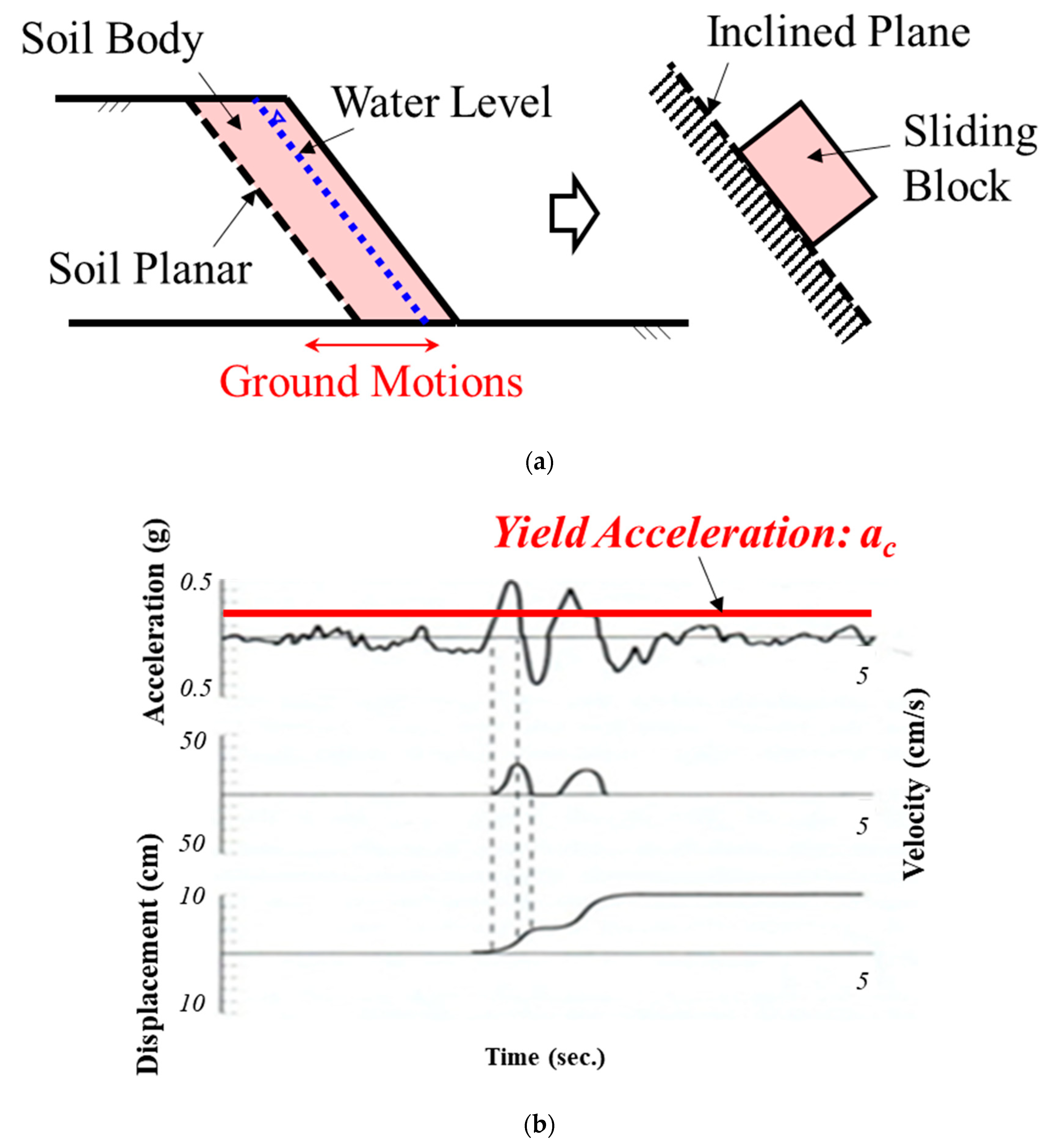
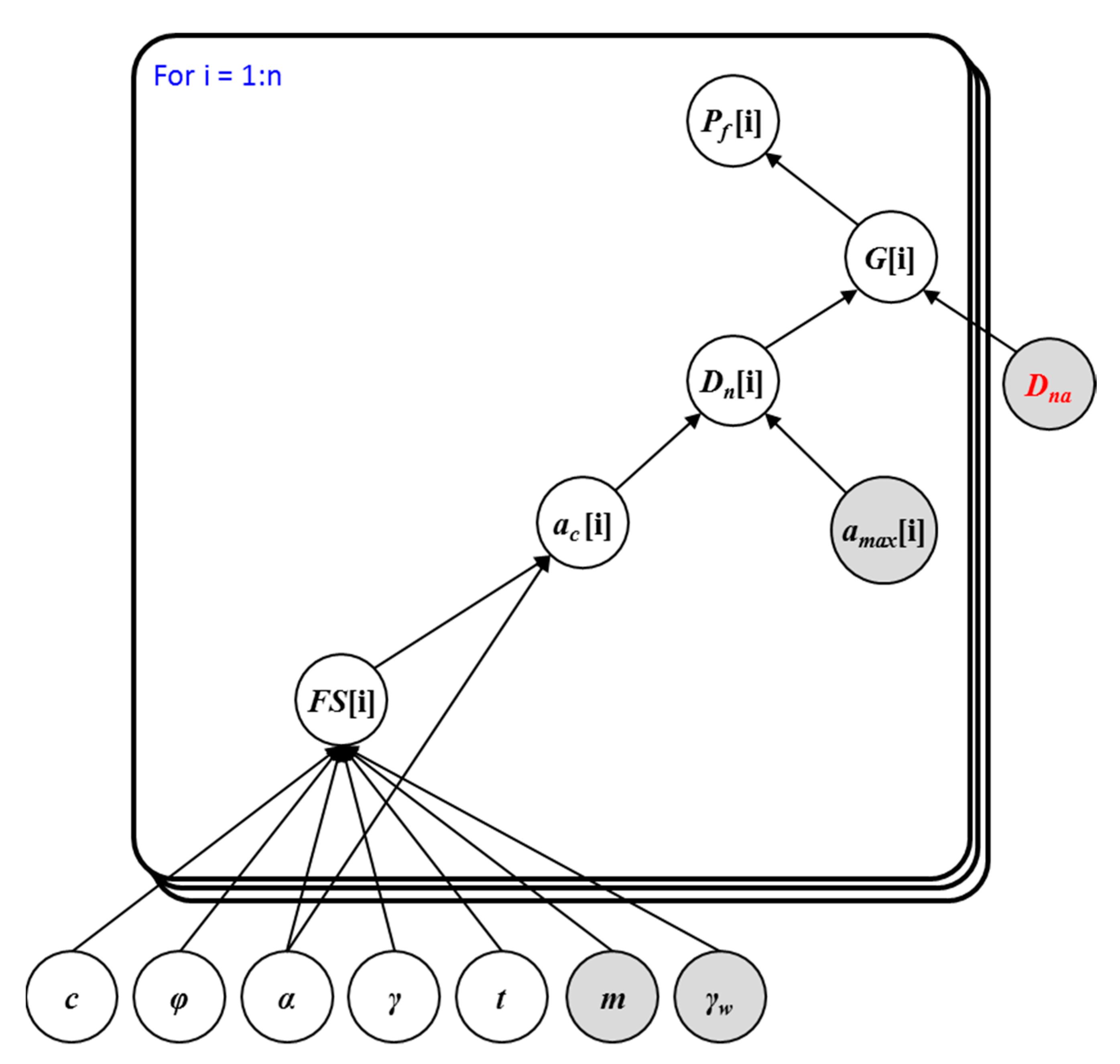
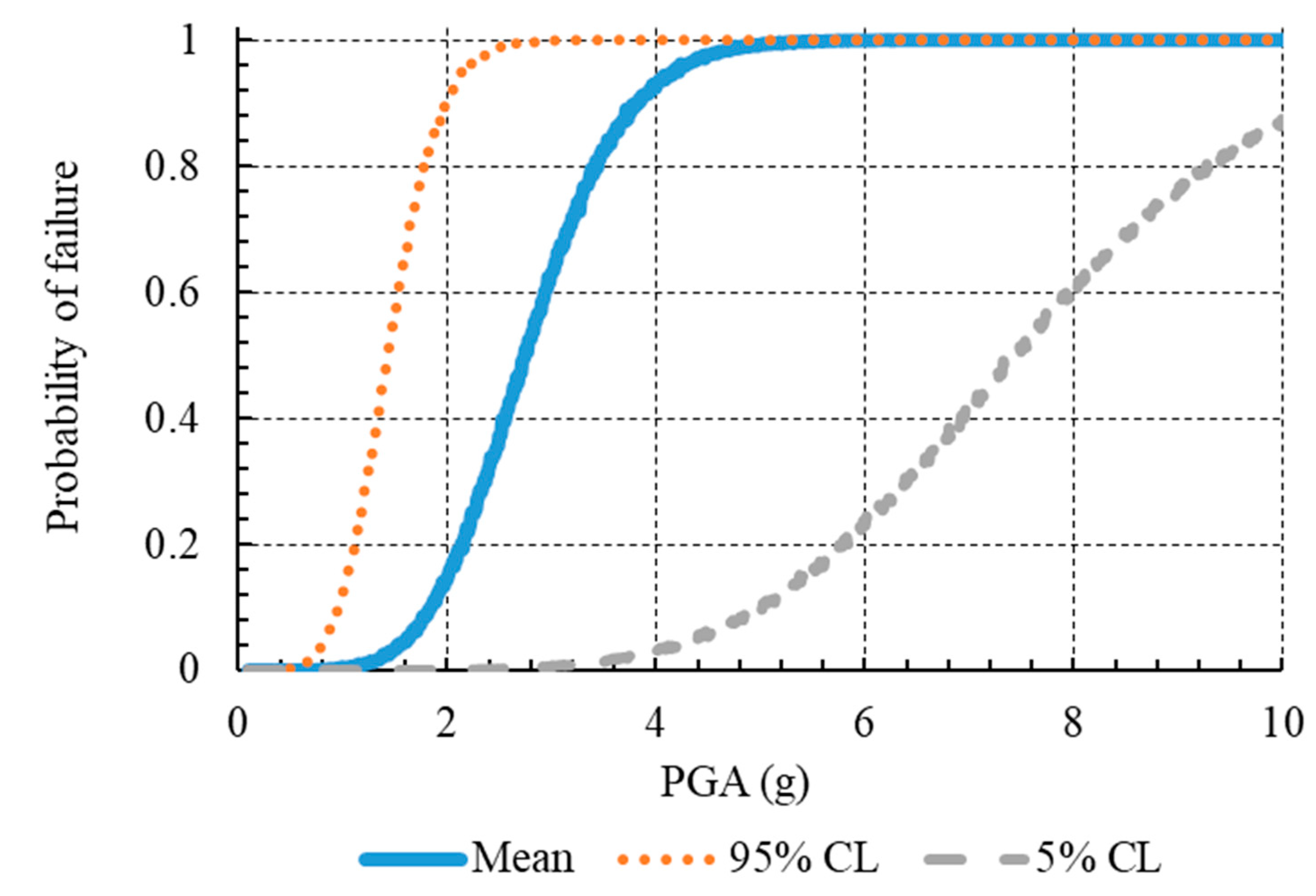
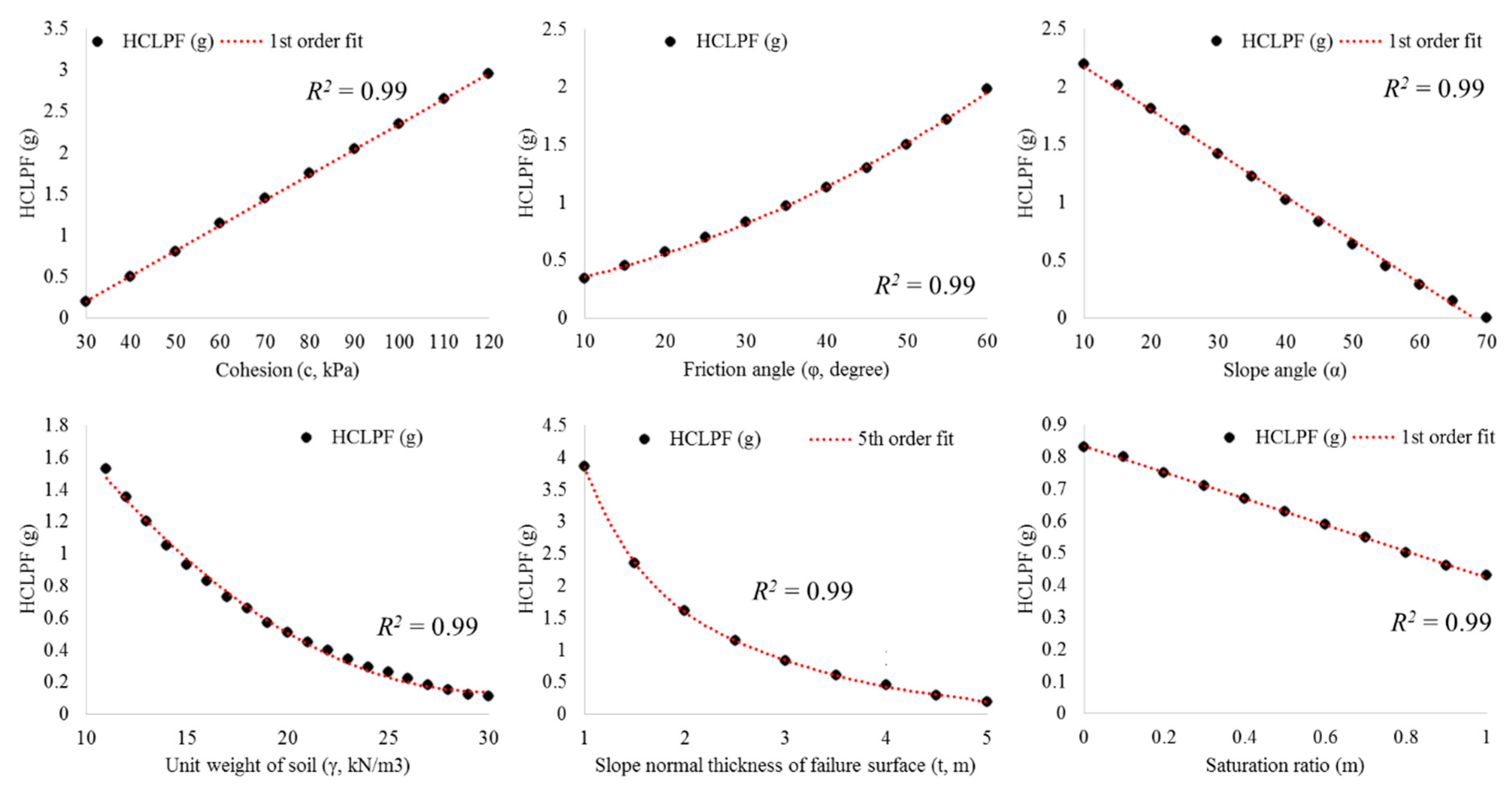
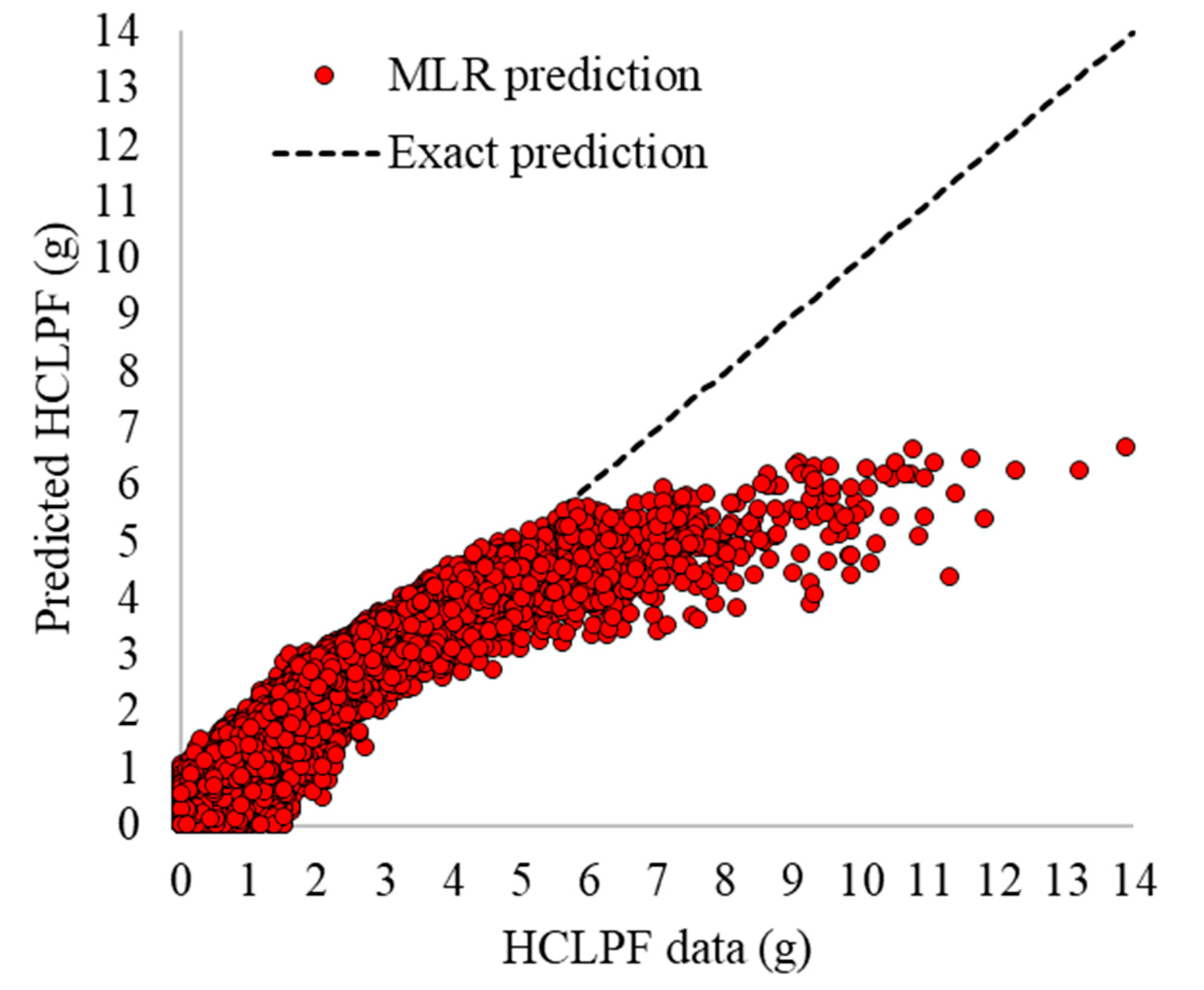
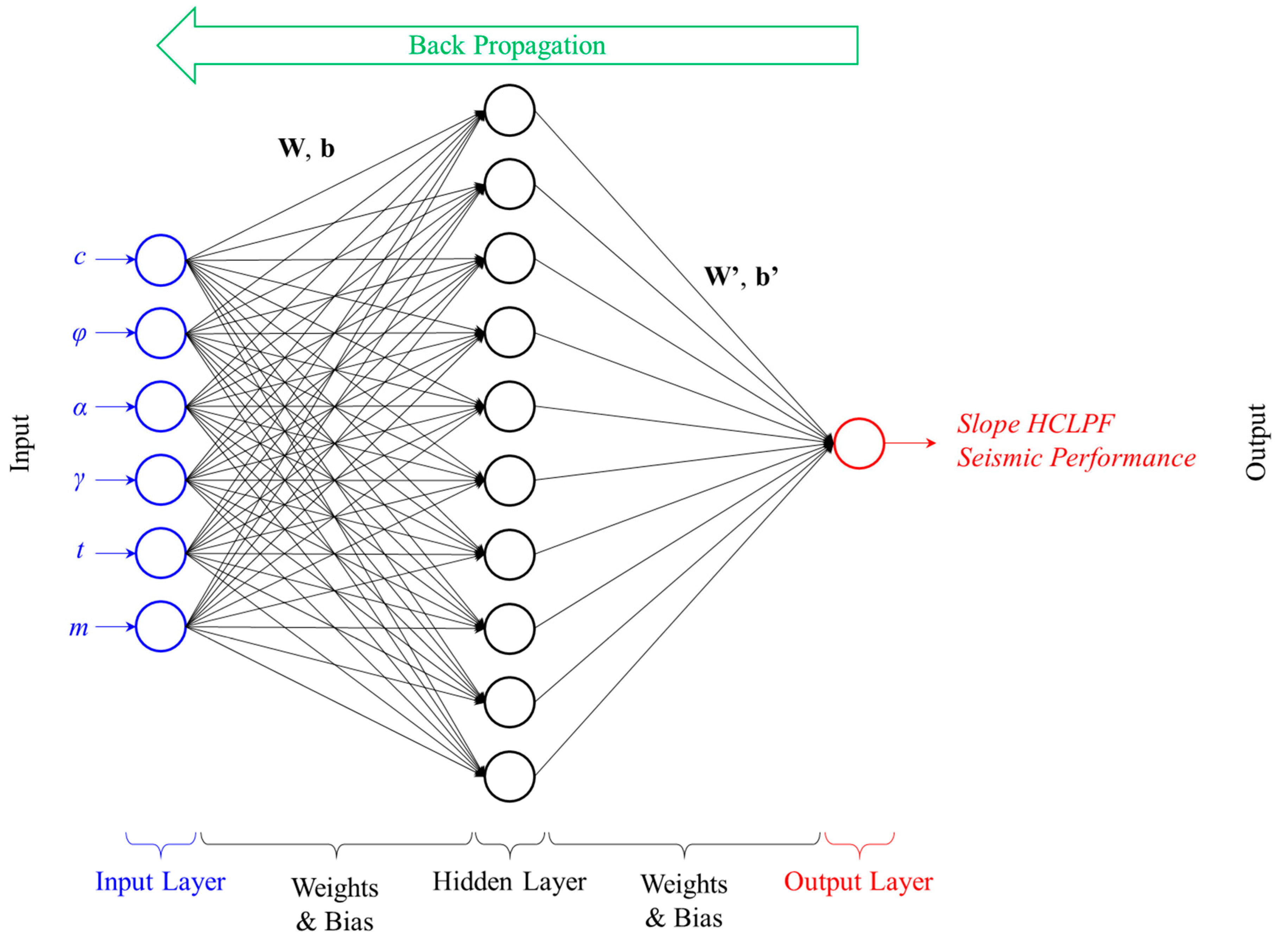
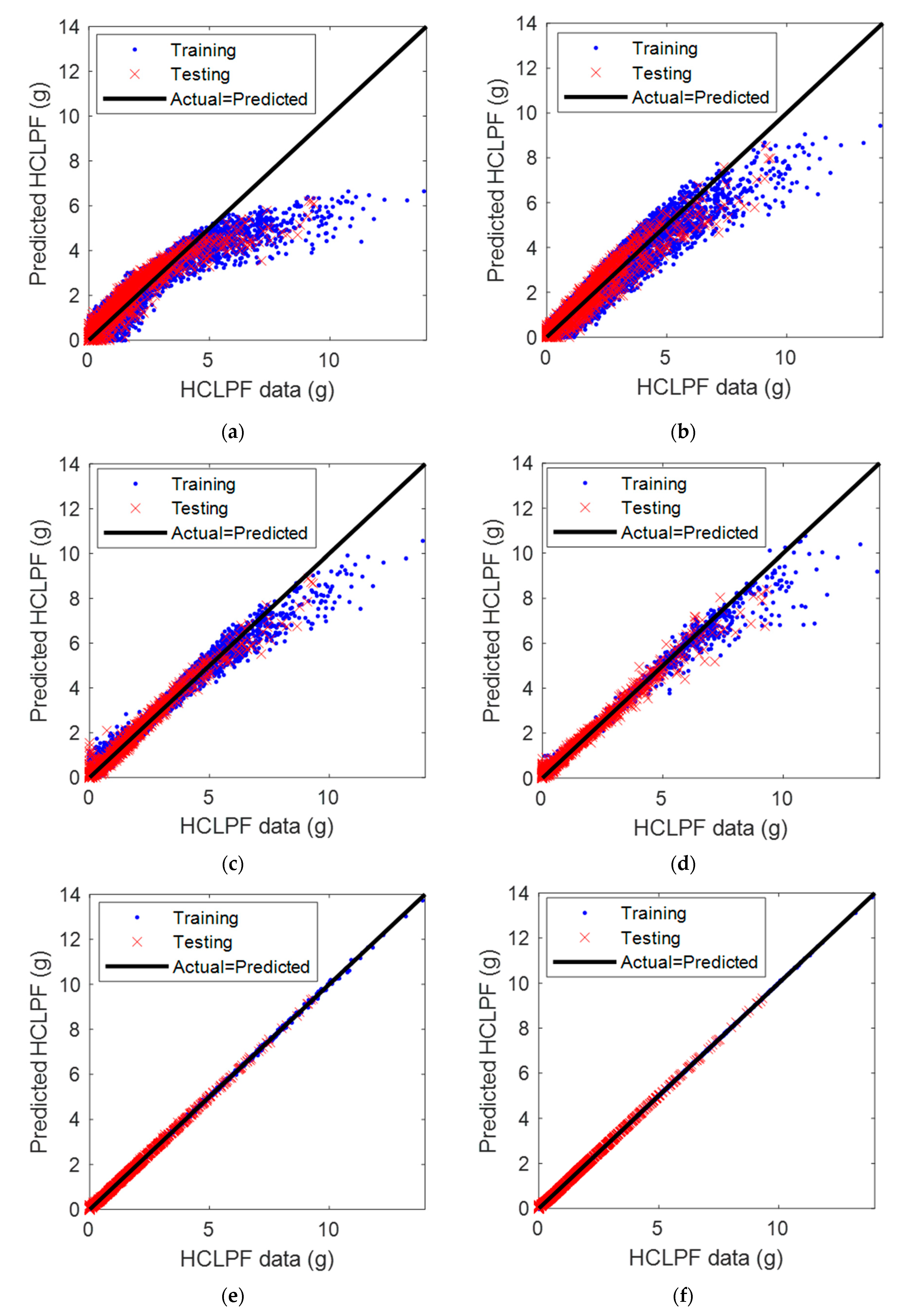
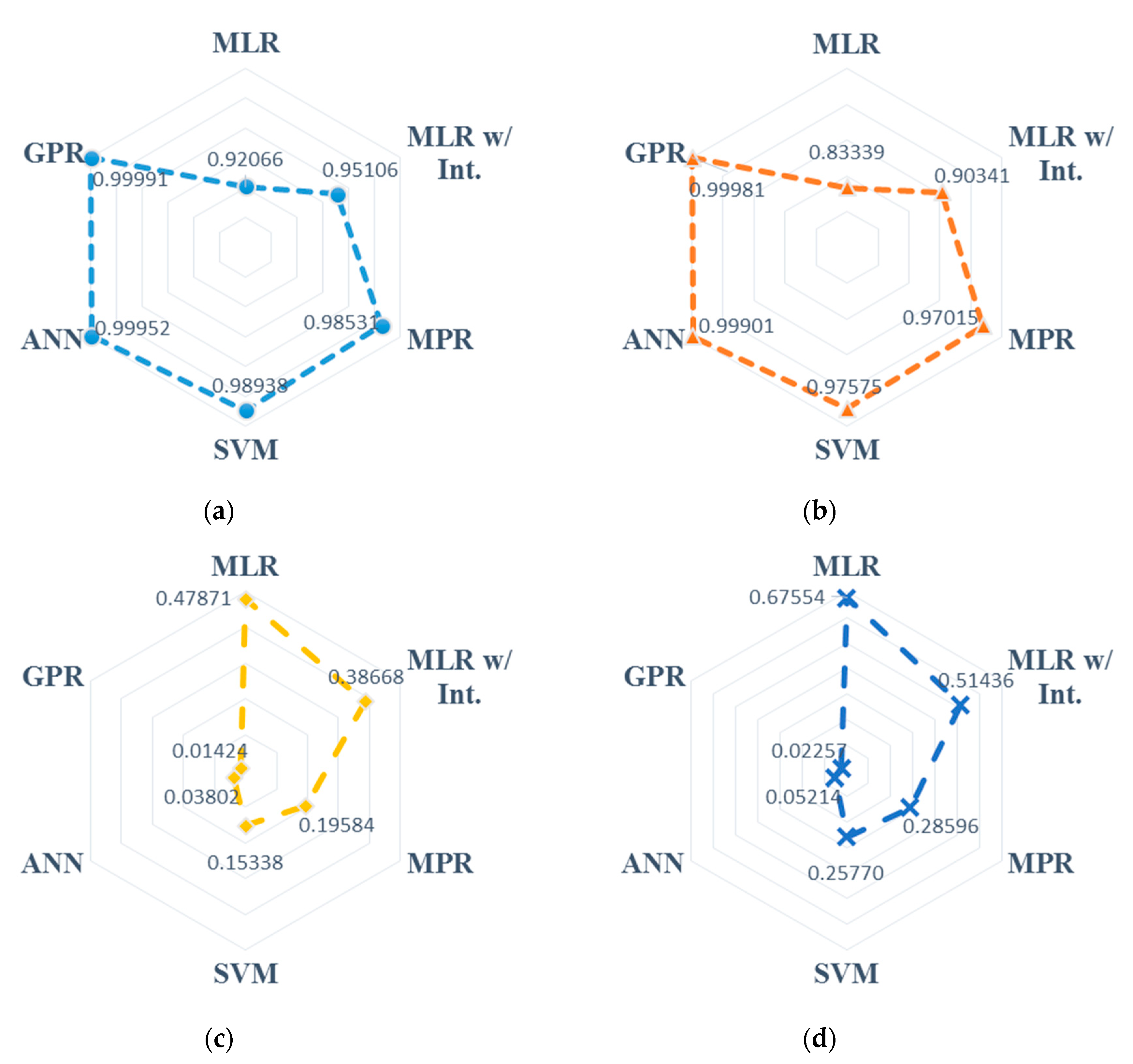
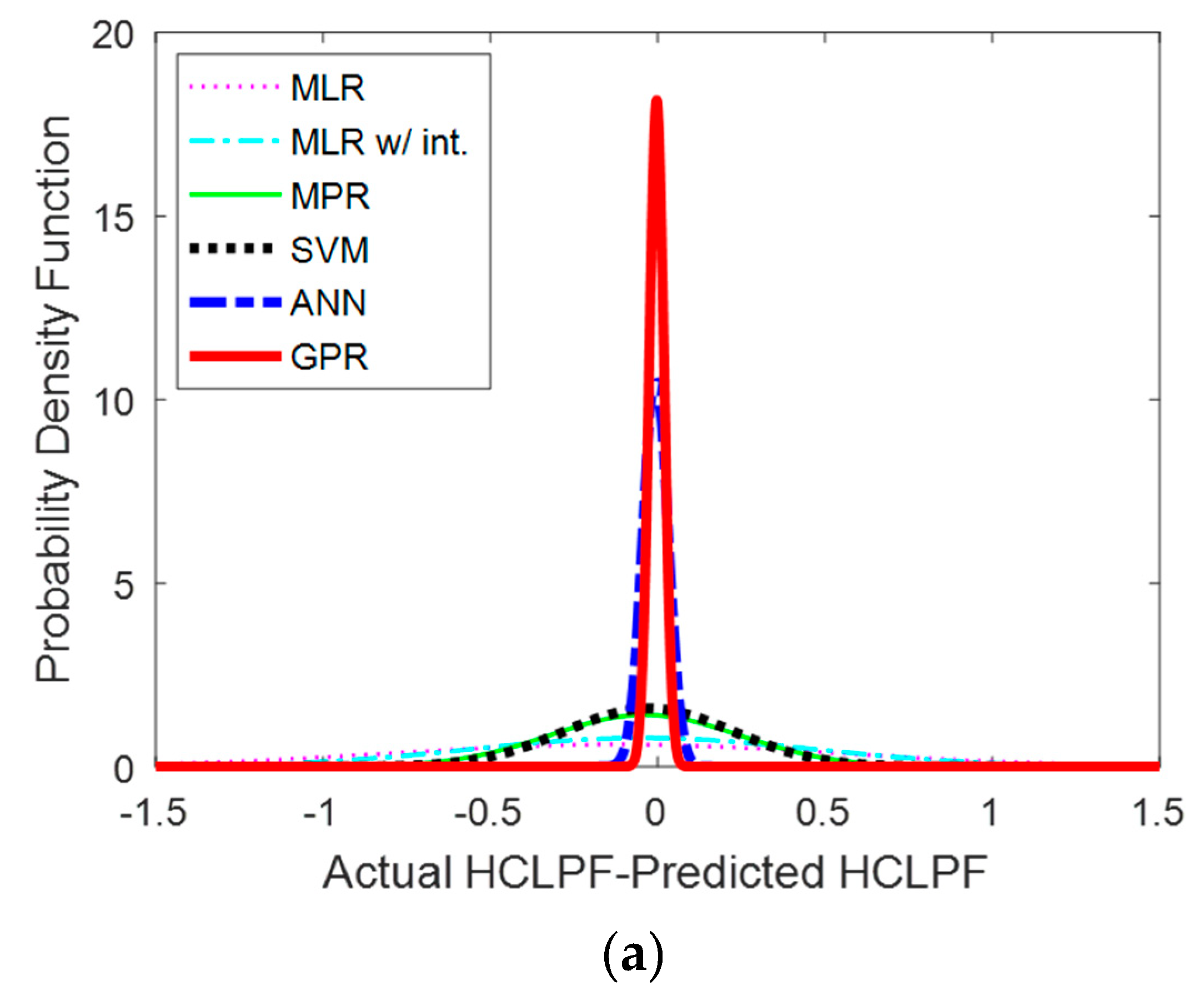
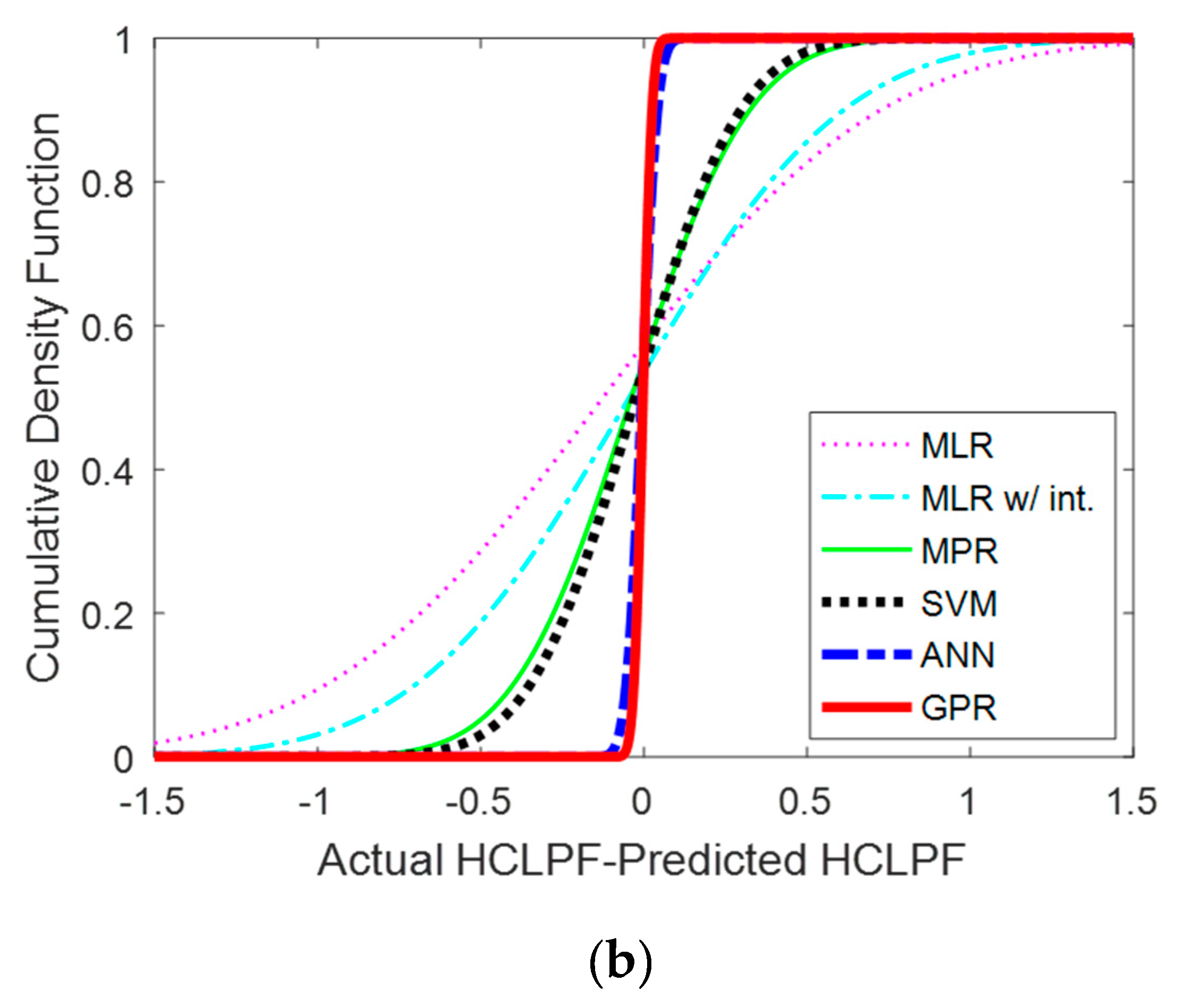
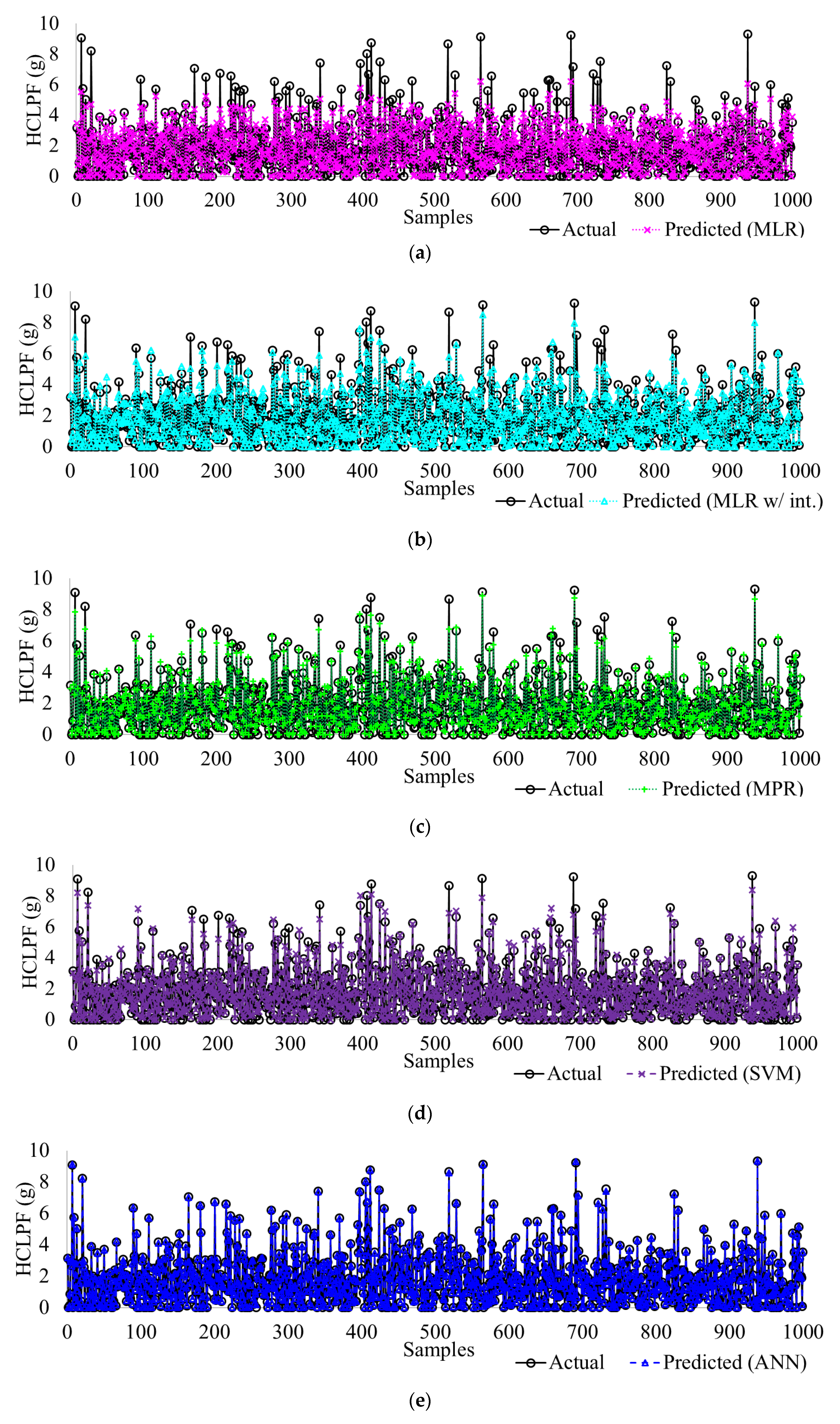
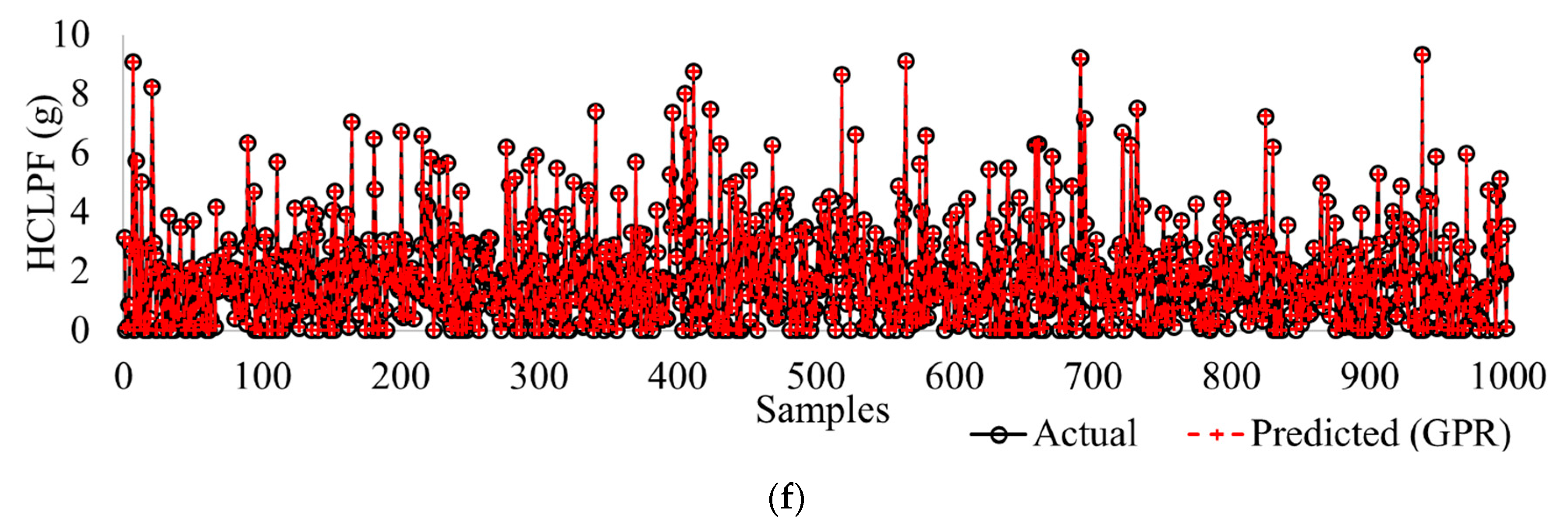
| Input Features | Minimum | Maximum | Distribution |
|---|---|---|---|
| c (kPa) | 30 | 120 | Uniform |
| φ (deg.) | 10 | 60 | Uniform |
| α (deg.) | 10 | 70 | Uniform |
| γ (kN/m3) | 11 | 30 | Uniform |
| t (m) | 1 | 5 | Uniform |
| m | 0 | 1 | Uniform |
| Output Features | Minimum | Maximum | - |
| HCLPF (g) | 0 | 13.9 | - |
| Dataset | Performance Measures | MLR | MLR w/Int. | MPR | SVM | ANN | GPR |
|---|---|---|---|---|---|---|---|
| Training Set | R | 0.92120 | 0.95403 | 0.98552 | 0.99376 | 0.99958 | 0.99994 |
| R2 | 0.83428 | 0.90927 | 0.97092 | 0.98539 | 0.99914 | 0.99988 | |
| MAE | 0.46368 | 0.37508 | 0.19443 | 0.11448 | 0.03682 | 0.01266 | |
| RMSE | 0.71673 | 0.53032 | 0.30023 | 0.21281 | 0.05153 | 0.01927 | |
| Testing Set | R | 0.92066 | 0.95106 | 0.98531 | 0.98938 | 0.99952 | 0.99991 |
| R2 | 0.83339 | 0.90341 | 0.97015 | 0.97575 | 0.99901 | 0.99981 | |
| MAE | 0.47871 | 0.38668 | 0.19584 | 0.15338 | 0.03802 | 0.01424 | |
| RMSE | 0.67554 | 0.51436 | 0.28596 | 0.25770 | 0.05214 | 0.02257 |
© 2020 by the authors. Licensee MDPI, Basel, Switzerland. This article is an open access article distributed under the terms and conditions of the Creative Commons Attribution (CC BY) license (http://creativecommons.org/licenses/by/4.0/).
Share and Cite
Kwag, S.; Hahm, D.; Kim, M.; Eem, S. Development of a Probabilistic Seismic Performance Assessment Model of Slope Using Machine Learning Methods. Sustainability 2020, 12, 3269. https://doi.org/10.3390/su12083269
Kwag S, Hahm D, Kim M, Eem S. Development of a Probabilistic Seismic Performance Assessment Model of Slope Using Machine Learning Methods. Sustainability. 2020; 12(8):3269. https://doi.org/10.3390/su12083269
Chicago/Turabian StyleKwag, Shinyoung, Daegi Hahm, Minkyu Kim, and Seunghyun Eem. 2020. "Development of a Probabilistic Seismic Performance Assessment Model of Slope Using Machine Learning Methods" Sustainability 12, no. 8: 3269. https://doi.org/10.3390/su12083269
APA StyleKwag, S., Hahm, D., Kim, M., & Eem, S. (2020). Development of a Probabilistic Seismic Performance Assessment Model of Slope Using Machine Learning Methods. Sustainability, 12(8), 3269. https://doi.org/10.3390/su12083269







